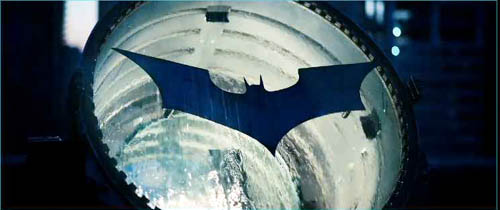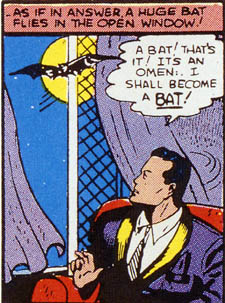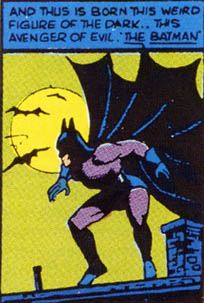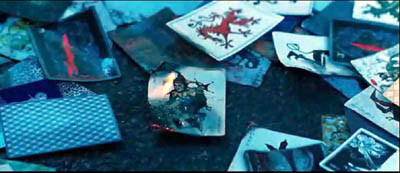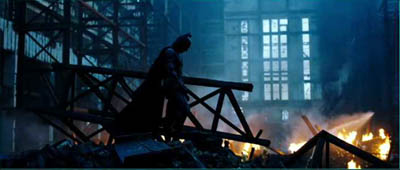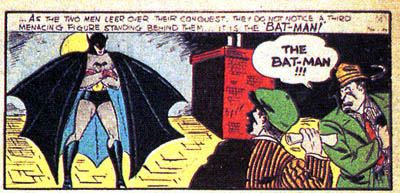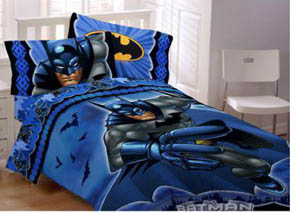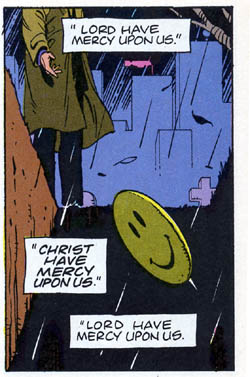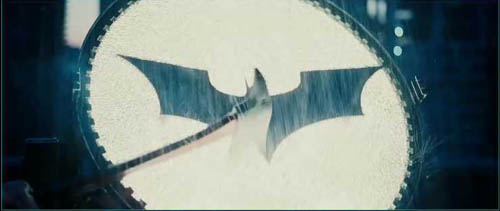Superheroes for sale
Saturday | August 16, 2008 open printable version
open printable version
DB here:
After a day at the movies, maybe I am living in a parallel universe. I go to see two films praised by people whose tastes I respect. I find myself bored and depressed. I’m also asking questions.
Over the twenty years since Batman (1989), and especially in the last decade or so, some tentpole pictures, and many movies at lower budget levels, have featured superheroes from the Golden and Silver age of comic books. By my count, since 2002, there have been between three and seven comic-book superhero movies released every year. (I’m not counting other movies derived from comic books or characters, like Richie Rich or Ghost World.)
Until quite recently, superheroes haven’t been the biggest money-spinners. Only eleven of the top 100 films on Box Office Mojo’s current worldwide-grosser list are derived from comics, and none ranks in the top ten titles. But things are changing. For nearly every year since 2000, at least one title has made it into the list of top twenty worldwide grossers. For most years two titles have cracked this list, and in 2007 there were three. This year three films have already arrived in the global top twenty: The Dark Knight, Iron Man, and The Incredible Hulk (four, if you count Wanted as a superhero movie).
This 2008 successes have vindicated Marvel’s long-term strategy to invest directly in movies and have spurred Warners to slate more comic-book titles. David S. Cohen analyses this new market here. So we are clearly in the midst of a Trend. My trip to the multiplex got me asking: What has enabled superhero comic-book movies to blast into a central spot in today’s blockbuster economy?
Enter the comic-book guys
It’s clearly not due to a boom in comic-book reading. Superhero books have not commanded a wide audience for a long time. Statistics on comic-book readership are closely guarded, but the expert commentator John Jackson Miller reports that back in 1959, at least 26 million comic books were sold every month. In the highest month of 2006, comic shops ordered, by Miller’s estimate, about 8 million books (and this total includes not only periodical comics but graphic novels, independent comics, and non-superhero titles). There have been upticks and downturns over the decades, but the overall pattern is a steep slump.
Try to buy an old-fashioned comic book, with staples and floppy covers, and you’ll have to look hard. You can get albums and graphic novels at the chain stores like Borders, but not the monthly periodicals. For those you have to go to a comics shop, and Hank Luttrell, one of my local purveyors of comics, estimates there aren’t more than 1000 of them in the U. S.
Moreover, there’s still a stigma attached to reading superhero comics. Even kitsch novels have long had a slightly higher cultural standing than comic books. Admitting you had read The Devil Wears Prada would be less embarrassing than admitting you read Daredevil.
For such reasons and others, the audience for superhero comics is far smaller than the audience for superhero movies. The movies seem to float pretty free of their origins; you can imagine a young Spider-Man fan who loved the series but never knew the books. What’s going on?
Men in tights, and iron pants
The films that disappointed me on that moviegoing day were Iron Man and The Dark Knight. The first seemed to me an ordinary comic-book movie endowed with verve by Robert Downey Jr.’s performance. While he’s thought of as a versatile actor, Downey also has a star persona—the guy who’s wound a few turns too tight, putting up a good front with rapid-fire patter (see Home for the Holidays, Wonder Boys, Kiss Kiss Bang Bang, Zodiac). Downey’s cynical chatterbox makes Iron Man watchable. When he’s not onscreen we get excelsior.
Christopher Nolan showed himself a clever director in Memento and a promising one in The Prestige. So how did he manage to make The Dark Knight such a portentously hollow movie? Apart from enjoying seeing Hong Kong in Imax, I was struck by the repetition of gimmicky situations–disguises, hostage-taking, ticking bombs, characters dangling over a skyscraper abyss, who’s dead really once and for all? The fights and chases were as unintelligible as most such sequences are nowadays, and the usual roaming-camera formulas were applied without much variety. Shoot lots of singles, track slowly in on everybody who’s speaking, spin a circle around characters now and then, and transition to a new scene with a quick airborne shot of a cityscape. Like Jim Emerson, I thought that everything hurtled along at the same aggressive pace. If I want an arch-criminal caper aiming for shock, emotional distress, and political comment, I’ll take Benny Chan’s New Police Story.
Then there are the mouths. This is a movie about mouths. I couldn’t stop staring at them. Given Batman’s cowl and his husky whisper, you practically have to lip-read his lines. Harvey Dent’s vagrant facial parts are especially engaging around the jaws, and of course the Joker’s double rictus dominates his face. Gradually I found Maggie Gyllenhaal’s spoonbill lips starting to look peculiar.
The expository scenes were played with a somber knowingness I found stifling. Quoting lame dialogue is one of the handiest weapons in a critic’s arsenal and I usually don’t resort to it; many very good movies are weak on this front. Still, I can’t resist feeling that some weighty lines were doing duty for extended dramatic development, trying to convince me that enormous issues were churning underneath all the heists, fights, and chases. Know your limits, Master Wayne. Or: Some men just want to watch the world burn. Or: In their last moments people show you who they really are. Or: The night is darkest before the dawn.
I want to ask: Why so serious?
Odds are you think better of Iron Man and The Dark Knight than I do. That debate will go on for years. My purpose here is to explore a historical question: Why comic-book superhero movies now?
Z as in Zeitgeist
More superhero movies after 2002, you say? Obviously 9/11 so traumatized us that we feel a yearning for superheroes to protect us. Our old friend the zeitgeist furnishes an explanation. Every popular movie can be read as taking the pulse of the public mood or the national unconscious.
I’ve argued against zeitgeist readings in Poetics of Cinema, so I’ll just mention some problems with them:
*A zeitgeist is hard to pin down. There’s no reason to think that the millions of people who go to the movies share the same values, attitudes, moods, or opinions. In fact, all the measures we have of these things show that people differ greatly along all these dimensions. I suspect that the main reason we think there’s a zeitgeist is that we can find it in popular culture. But we would need to find it independently, in our everyday lives, to show that popular culture reflects it.
*So many different movies are popular at any moment that we’d have to posit a pretty fragmented national psyche. Right now, it seems, we affirm heroic achievement (Indiana Jones and the Kingdom of the Crystal Skull, Kung Fu Panda, Prince Caspian) except when we don’t (Get Smart, The Dark Knight). So maybe the zeitgeist is somehow split? That leads to vacuity, since that answer can accommodate an indefinitely large number of movies. (We’d have to add fractions of our psyche that are solicited by Sex and the City and Horton Hears a Who!)
*The movie audience isn’t a good cross-section of the general public. The demographic profile tilts very young and moderately affluent. Movies are largely a middle-class teenage and twentysomething form. When a producer says her movie is trying to catch the zeitgeist, she’s not tracking retired guys in Arizona wearing white belts; she’s thinking mostly of the tastes of kids in baseball caps and draggy jeans.
* Just because a movie is popular doesn’t mean that people have found the same meanings in it that critics do. Interpretation is a matter of constructing meaning out of what a movie puts before us, not finding the buried treasure, and there’s no guarantee that the critic’s construal conforms to any audience member’s.
*Critics tend to think that if a movie is popular, it reflects the populace. But a ticket is not a vote for the movie’s values. I may like or dislike it, and I may do either for reasons that have nothing to do with its projection of my hidden anxieties.
*Many Hollywood films are popular abroad, in nations presumably possessing a different zeitgeist or national unconscious. How can that work? Or do audiences on different continents share the same zeitgeist?
Wait, somebody will reply, The Dark Knight is a special case! Nolan and his collaborators have strewn the film with references to post-9/11 policies about torture and surveillance. What, though, is the film saying about those policies? The blogosphere is already ablaze with discussions of whether the film supports or criticizes Bush’s White House. And the Editorial Board of the good, gray Times has noticed:
It does not take a lot of imagination to see the new Batman movie that is setting box office records, The Dark Knight, as something of a commentary on the war on terror.
You said it! Takes no imagination at all. But what is the commentary? The Board decides that the water is murky, that some elements of the movie line up on one side, some on the other. The result: “Societies get the heroes they deserve,” which is virtually a line from the movie.
I remember walking out of Patton (1970) with a hippie friend who loved it. He claimed that it showed how vicious the military was, by portraying a hero as an egotistical nutcase. That wasn’t the reading offered by a veteran I once talked to, who considered the film a tribute to a great warrior.
It was then I began to suspect that Hollywood movies are usually strategically ambiguous about politics. You can read them in a lot of different ways, and that ambivalence is more or less deliberate.
A Hollywood film tends to pose sharp moral polarities and then fuzz or fudge or rush past settling them. For instance, take The Bourne Ultimatum: Yes, the espionage system is corrupt, but there is one honorable agent who will leak the information, and the press will expose it all, and the malefactors will be jailed. This tactic hasn’t had a great track record in real life.
The constitutive ambiguity of Hollywood movies helpfully disarms criticisms from interest groups (“Look at the positive points we put in”). It also gives the film an air of moral seriousness (“See, things aren’t simple; there are gray areas”). That’s the bait the Times writers took.
I’m not saying that films can’t carry an intentional message. Bryan Singer and Ian McKellen claim the X-Men series criticizes prejudice against gays and minorities. Nor am I saying that an ambivalent film comes from its makers delicately implanting counterbalancing clues. Sometimes they probably do. More often, I think, filmmakers pluck out bits of cultural flotsam opportunistically, stirring it all together and offering it up to see if we like the taste. It’s in filmmakers’ interests to push a lot of our buttons without worrying whether what comes out is a coherent intellectual position. Patton grabbed people and got them talking, and that was enough to create a cultural event. Ditto The Dark Knight.
Back to basics
If the zeitgeist doesn’t explain the flourishing of the superhero movie in the last few years, what does? I offer some suggestions. They’re based on my hunch that the genre has brought together several trends in contemporary Hollywood film. These trends, which can commingle, were around before 2000, but they seem to be developing in a way that has created a niche for the superhero film.
The changing hierarchy of genres. Not all genres are created equal, and they rise or fall in status. As the Western and the musical fell in the 1970s, the urban crime film, horror, and science-fiction rose. For a long time, it would be unthinkable for an A-list director to do a horror or science-fiction movie, but that changed after Polanski, Kubrick, Ridley Scott, et al. gave those genres a fresh luster just by their participation. More recently, I argue in The Way Hollywood Tells It, the fantasy film arrived as a respectable genre, as measured by box-office receipts, critical respect, and awards. It seems that the sword-and-sorcery movie reached its full rehabilitation when The Lord of the Rings: The Return of the King scored its eleven Academy Awards.
The comic-book movie has had a longer slog from the B- and sub-B-regions. Superman, Flash Gordon, and Dick Tracy were all fodder for serials and low-budget fare. Prince Valiant (1954) was the only comics-derived movie of any standing in the 1950s, as I recall, and you can argue that it fitted into a cycle of widescreen costume pictures. (Though it looks like a pretty camp undertaking today.) Much later came revivals of the two most popular superheroes, Superman (1978) and Batman (1989).
The success of the Batman film, which was carefully orchestrated by Warners and its DC comics subsidiary, can be seen as preparing the grounds for today’s superhero franchises. The idea was to avoid simply reiterating a series, as the Superman movie did, or mocking it, as the Batman TV show did. The purpose was to “reimagine” the series, to “reboot” it as we now say, the way Frank Miller’s The Dark Knight Returns re-launched the Batman comic. Rebooting modernizes the mythos by reinterpreting it in a thematically serious and graphically daring way.
During the 1990s, less famous superheroes filled in as the Batman franchise tailed off. Examples were The Rocketeer (1991), Timecop (1994), The Crow (1994) and The Crow: City of Angels (1996), Judge Dredd (1995), Men in Black (1997), Spawn (1997), Blade (1998), and Mystery Men (1999). Most of these managed to fuse their appeals with those of another parvenu genre, the kinetic action-adventure movie.
Significantly, these were typically medium-budget films from semi-independent companies. Although some failed, a few were huge and many earned well, especially once home video was reckoned in. Moreover, the growing number of titles, sometimes featuring name actors, fueled a sense that this genre was becoming important. As often happens, marginal companies developed the market more nimbly than the big ones, who tend to move in once the market has matured.
I’d also suggest that The Matrix (1999) helped legitimize the cycle. (Neo isn’t a superhero? In the final scene he can fly.) The pseudophilosophical aura this movie radiated, as well as its easy familiarity with comics, videogames, and the Web, made it irrevocably cool. Now ambitious young directors like Nolan, Singer, and Brett Ratner could sign such projects with no sense they were going downmarket.
The importance of special effects. Arguably there were no fundamental breakthroughs in special-effects technology from the 1940s to the 1960s. But with motion-control cinematography, showcased in the first Star Wars installment (1977) filmmakers could create a new level of realism in the use of miniatures. Later developments in matte work, blue- and green-screen techniques, and digital imagery were suited to, and driven by, the other genres that were on the rise—horror, science-fiction, and fantasy—but comic-book movies benefited as well. The tagline for Superman was “You’ll believe a man can fly.”
Special effects thereby became one of a film’s attractions. Instead of hiding the technique, films flaunted it as a mark of big budgets and technological sophistication. The fantastic powers of superheroes cried out for CGI, and it may be that convincing movies in the genre weren’t really ready until the software matured.
The rise of franchises. Studios have always sought predictability, and the classic studio system relied on stars and genres to encourage the audience to return for more of what it liked. But as film attendance waned, producers looked for other models. One that was successful was the branded series, epitomized in the James Bond films. With the rise of the summer blockbuster, producers searched for properties that could be exploited in a string of movies. A memorable character could tie the installments together, and so filmmakers turned to pop literature (e.g., the Harry Potter books) and comic books. Today, Marvel Enterprises is less concerned with publishing comics than with creating film vehicles for its 5000 characters. Indeed, to get bank financing it put up ten of its characters as collateral!
Yet a single character might not sustain a robust franchise. Henry Jenkins has written about how popular culture is gravitating to multi-character “worlds” that allow different media texts to be carved out of them. Now that periodical sales of comics have flagged, the tail is wagging the dog. The 5000 characters in the Marvel Universe furnish endless franchise opportunities. If you stayed for the credit cookie at the end of Iron Man, you saw the setup for a sequel that will pair the hero with at least one more Marvel protagonist.
Merchandising and corporate synergy. It’s too obvious to dwell on, but superhero movies fit neatly into the demand that franchises should spawn books, TV shows, soundtracks, toys, apparel, and so on. Time Warner’s acquisition of DC Comics was crucial to the cross-platform marketing of the first Batman. Moreover, most comics readers are relatively affluent (a big change from my boyhood), so they have the income to buy action figures and other pricy collectibles, like a Batbed.
The shift from an auteur cinema to a genre cinema. The classic studio system maintained a fruitful, sometimes tense, balance between directorial expression and genre demands. Somewhere in recent decades that balance has split into polarities. We now have big-budget genre films that made by directors of no discernible individuality, and small “personal” films that showcase the director’s sensibility. There have always been impersonal craftsmen in Hollywood, but the most distinctive directors could often bring their own sensibilities to projects big or small.
David Lynch could make Dune (1984) part of his own oeuvre, but since then we have many big-budget genre pictures that bear no signs of directorial individuality. In particular, science-fiction, fantasy, and superhero movies demand so much high-tech input, so much preparation, so many logistical tasks in shooting, and such intensive postproduction, that economy of effort favors a standardized look and feel. Hence perhaps the recourse to well-established techniques of shooting and cutting; intensified continuity provides a line of least resistance. A comic-book movie can succeed if it doesn’t stray from the fanbase’s expectations and swiftly initiates the newbies. Not much directorial finesse is needed, as 300 (2007) shows.
The development of the megapicture may have led the more talented directors to the “one for them, one for me” motto. Think of the difference between Burton’s Planet of the Apes or even Sweeney Todd and, say, Ed Wood or Big Fish. Or think of the moments of elegance in Memento and The Prestige, as opposed to the blunt handling of Batman Begins and The Dark Knight.
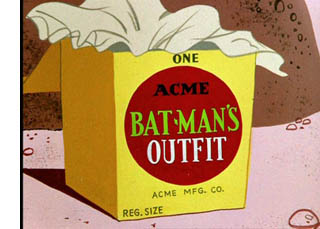 Shock and awe in presentation. The rise of the multiplex meant not only an upgrade in comfort (my back appreciates the tilting seats) but also a demand for big pictures and big sound. Smaller, more intimate movies look woeful on your megascreen, and what’s the point of Dolby surround channels if you’re watching a Woody Allen picture? Like science-fiction and fantasy, the adventures of a superhero in yawning landscapes fill the demand for immersion in a punchy, visceral entertainment. Scaling the film for Imax, as Superman Returns and The Dark Knight have, is the next step in this escalation.
Shock and awe in presentation. The rise of the multiplex meant not only an upgrade in comfort (my back appreciates the tilting seats) but also a demand for big pictures and big sound. Smaller, more intimate movies look woeful on your megascreen, and what’s the point of Dolby surround channels if you’re watching a Woody Allen picture? Like science-fiction and fantasy, the adventures of a superhero in yawning landscapes fill the demand for immersion in a punchy, visceral entertainment. Scaling the film for Imax, as Superman Returns and The Dark Knight have, is the next step in this escalation.
Too much is never enough. Since the 1980s, mass-audience pictures have gravitated toward ever more exaggerated presentation of momentary effects. In a comedy, if a car is about to crash, everyone inside must stare at the camera and shriek in concert. Extreme wide-angle shooting makes faces funny in themselves (or so Barry Sonnenfeld thinks). Action movies shift from slo-mo to fast-mo to reverse-mo, all stitched together by ramping, because somebody thinks these devices make for eye candy. Steep high and low angles, familiar in 1940s noir films, were picked up in comics, which in turn re-influenced movies.
Movies now love to make everything airborne, even the penny in Ghost. Things fly out at us, and thanks to surround channels we can hear them after they pass. It’s not enough simply to fire an arrow or bullet; the camera has to ride the projectile to its destination—or, in Wanted, from its target back to its source. In 21 of earlier this year, blackjack is given a monumentality more appropriate to buildings slated for demolition: giant playing cards whoosh like Stealth fighters or topple like brick walls.
I’m not against such one-off bursts of imagery. There’s an undoubted wow factor in seeing spent bullet casings shower into our face in The Matrix.
I just ask: What do such images remind us of? My answer: Comic book panels, those graphically dynamic compositions that keep us turning the pages. In fact, we call such effects “cartoonish.” Here’s an example from Watchmen, where the slow-motion effect of the Smiley pin floating down toward us is sustained by a series of lines of dialogue from the funeral service.
With comic-book imagery showing up in non-comic-book movies, one source may be greater reliance on storyboards and animatics. Spfx demand intensive planning, so detailed storyboarding was a necessity. Once you’re planning shot by shot, why not create very fancy compositions in previsualization? Spielberg seems to me the live-action master of “storyboard cinema.” And of course storyboards look like comic-book pages.
The hambone factor. In the studio era, star acting ruled. A star carried her or his persona (literally, mask) from project to project. Parker Tyler once compared Hollywood star acting to a charade; we always recognized the person underneath the mime.
This is not to say that the stars were mannequins or dead meat. Rather, like a sculptor who reshapes a piece of wood, a star remolded the persona to the project. Cary Grant was always Cary Grant, with that implausible accent, but the Cary Grant of Only Angels Have Wings is not that of His Girl Friday or Suspicion or Notorious or Arsenic and Old Lace. Or compare Barbara Stanwyck in The Lady Eve, Double Indemnity, and Meet John Doe. Young Mr. Lincoln is not the same character as Mr. Roberts, but both are recognizably Henry Fonda.
Dress them up as you like, but their bearing and especially their voices would always betray them. As Mr. Kralik in The Shop around the Corner, James Stewart talks like Mr. Smith on his way to Washington. In The Little Foxes, Herbert Marshall and Bette Davis sound about as southern as I do.
Star acting persisted into the 1960s, with Fonda, Stewart, Wayne, Crawford, and other granitic survivors of the studio era finishing out their careers. Star acting continues in what scholar Steve Seidman has called “comedian comedy,” from Jerry Lewis to Adam Sandler and Jack Black. Their characters are usually the same guy, again. Arguably some women, like Sandra Bullock and Ashlee Judd, also continued the tradition.
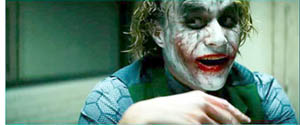 On the whole, though, the most highly regarded acting has moved closer to impersonation. Today your serious actors shape-shift for every project—acquiring accents, burying their faces in makeup, gaining or losing weight. We might be inclined to blame the Method, but classical actors went through the same discipline. Olivier, with his false noses and endless vocal range, might be the impersonators’ patron saint. His followers include Streep, Our Lady of Accents, and the self-flagellating young De Niro. Ironically, although today’s performance-as-impersonation aims at greater naturalness, it projects a flamboyance that advertises its mechanics. It can even look hammy. Thus, as so often, does realism breed artifice.
On the whole, though, the most highly regarded acting has moved closer to impersonation. Today your serious actors shape-shift for every project—acquiring accents, burying their faces in makeup, gaining or losing weight. We might be inclined to blame the Method, but classical actors went through the same discipline. Olivier, with his false noses and endless vocal range, might be the impersonators’ patron saint. His followers include Streep, Our Lady of Accents, and the self-flagellating young De Niro. Ironically, although today’s performance-as-impersonation aims at greater naturalness, it projects a flamboyance that advertises its mechanics. It can even look hammy. Thus, as so often, does realism breed artifice.
Horror and comic-book movies offer ripe opportunities for this sort of masquerade. In a straight drama, confined by realism, you usually can’t go over the top, but given the role of Hannibal Lector, there is no top. The awesome villain is a playground for the virtuoso, or the virtuoso in training. You can overplay, underplay, or over-underplay. You can also shift registers with no warning, as when hambone supreme Orson Welles would switch from a whisper to a bellow. More often now we get the flip from menace to gargoylish humor. Jack Nicholson’s “Heeere’s Johnny” in The Shining is iconic in this respect. In classic Hollywood, humor was used to strengthen sentiment, but now it’s used to dilute violence.
Such is the range we find in The Dark Knight. True, some players turn in fairly low-key work. Morgan Freeman plays Morgan Freeman, Michael Caine does his usual punctilious job, and Gary Oldman seems to have stumbled in from an ordinary crime film. Maggie Gylenhaal and Aaron Eckhart provide a degree of normality by only slightly overplaying; even after Harvey Dent’s fiery makeover Eckhart treats the role as no occasion for theatrics.
All else is Guignol. The Joker’s darting eyes, waggling brows, chortles, and restless licking of his lips send every bit of dialogue Special Delivery. Ledger’s performance has been much praised, but what would count as a bad line reading here? The part seems designed for scenery-chewing. By contrast, poor Bale has little to work with. As Bruce Wayne, he must be stiff as a plank, kissing Rachel while keeping one hand suavely tucked in his pocket, GQ style. In his Bat-cowl, he’s missing as much acreage of his face as Dent is, so all Bale has is the voice, over-underplayed as a hoarse bark.
In sum, our principals are sweating through their scenes. You get no strokes for making it look easy, but if you work really hard you might get an Oscar.
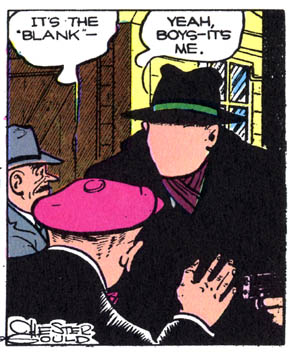 A taste for the grotesque. Horror films have always played on bodily distortions and decay, but The Exorcist (1973) raised the bar for what sorts of enticing deformities could be shown to mainstream audiences. Thanks to new special effects, movies like Total Recall (1990) were giving us cartoonish exaggerations of heads and appendages.
A taste for the grotesque. Horror films have always played on bodily distortions and decay, but The Exorcist (1973) raised the bar for what sorts of enticing deformities could be shown to mainstream audiences. Thanks to new special effects, movies like Total Recall (1990) were giving us cartoonish exaggerations of heads and appendages.
But of course the caricaturists got here first, from Hogarth and Daumier onward. Most memorably, Chester Gould’s Dick Tracy strip offered a parade of mutilated villains like Flattop, the Brow, the Mole, and the Blank, a gentleman who was literally defaced. The Batman comics followed Gould in giving the protagonist an array of adversaries who would even raise an eyebrow in a Manhattan subway car.
Eisenstein once argued that horrific grotesquerie was unstable and hard to sustain. He thought that it teetered between the comic-grotesque and the pathetic-grotesque. That’s the difference, I suppose, between Beetlejuice and Edward Scissorhands, or between the Joker and Harvey Dent. In any case, in all its guises the grotesque is available to our comic-book pictures, and it plays nicely into the oversize acting style that’s coming into favor.
You’re thinking that I’ve gone on way too long, and you’re right. Yet I can’t withhold two more quickies:
The global recognition of anime and Hong Kong swordplay films. During the climactic battle between Iron Man 2.0 and 3.0, so reminiscent of Transformers, I thought: “The mecha look has won.”
Learning to love the dark. That is, filmmakers’ current belief that “dark” themes, carried by monochrome cinematography, somehow carry more prestige than light ones in a wide palette. This parallels comics’ urge for legitimacy by treating serious subjects in somber hues, especially in graphic novels.
Time to stop! This is, after all, just a list of causes and conditions that occurred to me after my day in the multiplex. I’m sure we can find others. Still, factors like these seem to me more precise and proximate causes for the surge in comic-book films than a vague sense that we need these heroes now. These heroes have been around for fifty years, so in some sense they’ve always been needed, and somebody may still need them. The major media companies, for sure. Gazillions of fans, apparently. Me, not so much. But after Hellboy II: The Golden Army I live in hope.
Thanks to Hank Luttrell for information about the history of the comics market.
The superhero rankings I mentioned are: Spider-Man 3 (no. 12), Spider-Man (no. 17), Spider-Man 2 (no. 23), The Dark Knight (currently at no. 29, but that will change), Men in Black (no. 42), Iron Man (no. 45), X-Men: The Last Stand (no. 75), 300 (no. 80), Men in Black II (no. 85), Batman (no. 95), and X2: X-Men United (no. 98). The usual caveat applies: This list is based on unadjusted grosses and so favors recent titles, because of inflation and the increased ticket prices. If you adjust for these factors, the list of 100 all-time top grossers includes seven comics titles, with the highest-ranking one being Spider-Man, at no. 33.
For a thoughtful essay written just as the trend was starting, see Ken Tucker’s 2000 Entertainment Weekly piece, “Caped Fears.” It’s incompletely available here.
Comics aficionados may object that I am obviously against comics as a whole. True, I have little interest in superhero comic books. As a boy I read the DC titles, but I preferred Mad, Archie, Uncle Scrooge, and Little Lulu. In high school and college I missed the whole Marvel revolution and never caught up. Like everybody else in the 1980s I read The Dark Knight Returns, but I preferred Watchmen (and I look forward to the movie). I like the Hellboy movies too. But I’m not gripped by many of the newest trends in comics. Sin City strikes me as a fastidious piece of draftsmanship exercised on formulaic material, as if Mickey Spillane were rewritten by Nicholson Baker. Since the 80s my tastes have run to Ware, Clowes, a few manga, and especially Eurocomics derived from the clear-line tradition (Chaland, Floc’h, Swarte, etc.). I believe that McCay and Herriman are major twentieth-century artists, with Chester Gould and Cliff Sterrett worth considering for the honor too.
You can argue that Oliver Stone’s films create ambivalence inadvertently. JFK seems to have a clear-cut message, but the plotting is diverted by so many conspiracy scenarios that the viewer might get confused about what exactly Stone is claiming really happened.
On the ways that worldmaking replaces character-centered media storytelling, the crucial discussion is in Henry Jenkins, Convergence Culture: Where Old and New Media Collide (New York University Press, 2007), 113-122.
On franchise-building, see the detailed account in detail in Eileen R. Meehan, “‘Holy Commodity Fetish, Batman!’: The Political Economy of a Commercial Intertext,” in The Many Lives of the Batman, ed. Roberta E. Pearson and William Uricchio (Routledge, 1991), 47-65. Other essays in this collection offer information on the strategies of franchise-building.
Just as Star Wars helped legitimate itself by including Alec Guinness in its cast (surely he wouldn’t be in a potboiler), several superhero movies have a proclivity for including a touch of British class: McKellan and Stewart in X-Men, Caine in the Batman series. These old reliables like to keep busy and earn a spot of cash.
PS: 21 August 2008: This post has gotten some intriguing responses, both on the Internets and in correspondence with me, so I’m adding a few here.
Jim Emerson elaborated on the zeitgeist motif in an entry at Scanners. At Crooked Timber, John Holbo examines how much the film’s dark cast owes to the 1990s reincarnation of Batman. Peter Coogan writes to tell me that he makes a narrower version of the zeitgeist argument in relation to superheroes in Chapter 10 of his book, Superhero: The Secret Origin of a Genre, to be reprinted next year. Even the more moderate form he proposes doesn’t convince me, I’m afraid, but the book ought to be of value to readers interested in the genre.
From Stew Fyfe comes a letter offering some corrections and qualifications.
*Stew points out that chain stores like Borders do sell some periodical comics titles, though not always regularly.
*Comics publishing, while not at the circulation levels seen in the golden era, is undergoing something of a resurgence now, possibly because of the success of the franchise movies. Watchmen sales alone will be a big bump in anticipation of the movie.
*As for my claim that film is driving the publishing side, Stew suggests that the relations between the media are more complicated. The idea that the tail wags the dog might apply to DC, but Marvel has made efforts to diversify the relations between the books and the films.
They’ve done things like replacing the Hulk with a red, articulate version of the character just before the movie came out (which is odd because if there’s one thing that the general public knows about the character is that he’s green and he grunts). They’ve also handed the Hulk’s main title over to a minor character, Hercules. They’ve spent a year turning Iron Man, in the main continuity, into something of a techno-fascist (if lately a repentant one) who locks up other superheroes.
Stew speculates that Marvel is trying to multiply its audiences. It relies on its main “continuity books” to serve the fanbase who patronizes the shops, and the films sustain each title’s proprietary look and feel. In addition, some of the books offer fresh material for anyone who might want to buy the comic after seeing the film; this tactic includes reprinted material and rebooted continuity lines in the Ultimate series. Marvel has also brought in film and TV creators as writers (Joss Whedon, Kevin Smith), while occasionally comics artists work in TV shows like Heroes, Lost, and Battlestar Galactica. So the connections are more complex than I was indicating.
Thanks to all these readers for their comments.












